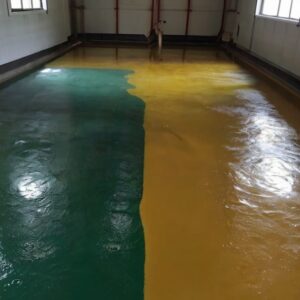When diving into protective coatings, you’ll likely encounter two players: polyurea and epoxy. Both have their unique strengths and applications, making the choice between them critical for ensuring the longevity and durability of your project.
Key Differences
Cure Time
One of the most striking differences lies in cure time. Polyurea cures within minutes, offering rapid application and minimal downtime. This characteristic is beneficial for projects requiring swift turnaround. Epoxy coatings take longer to cure, often several hours to overnight, depending on the formula and environmental conditions.
Durability and Flexibility
When it comes to withstand harsh conditions, both materials shine, albeit in slightly different arenas. Polyurea’s forte is its exceptional elasticity, making it ideal for surfaces that experience movement or expansion, as it can stretch and return to its original shape without cracking. On the durability front, epoxy coatings are tough and offer superior resistance to abrasion and chemicals, making them suitable for high-traffic areas and industrial settings.
Application Environments
The application environment is important in decision-making. Polyurea’s quick cure time and tolerance to varied temperatures allow for application in a broader range of conditions, including colder climates where traditional coatings might falter. Epoxy, while versatile, performs best in controlled environments, with its application and curing process more sensitive to humidity and temperature.
Longevity and Maintenance
Both coatings boast impressive lifespans when applied correctly. The maintenance journey might diverge. Polyurea’s resilience to moisture and UV light contributes to its longevity, requiring less frequent touch-ups. Epoxy, while sturdy, may succumb to yellowing over time under UV exposure and could necessitate a more rigorous maintenance schedule to retain its aesthetic appeal.
Aesthetics and Finish
Epoxy coatings are renowned for their sleek, high-gloss finish, offering a range of colors that lend a vibrant, polished look to floors and other surfaces. Polyurea, while also available in various hues, tends towards a more matte finish. The choice here might hinge on the visual expectations and functional needs of your space.
Cost Implications
Budget considerations cannot be overlooked. Initially, polyurea might appear more costly due to its material and application expenses. Its durability and reduced maintenance needs could lead to savings over time. Epoxy’s lower upfront cost is attractive, but it’s essential to factor in long-term maintenance and potential reapplication costs.
Where Each Shines

When it comes to selecting the right coating for various applications, understanding the distinct advantages of polyurea and epoxy is important. For industrial floors and warehouses, where heavy machinery, constant foot traffic, and the inevitable spillage are common, the durability and wear resistance of epoxy coatings make them a preferred option. Epoxy’s tough nature allows it to withstand these rigorous conditions for longer periods, thereby reducing the need for frequent maintenance and replacement. In contrast, for decks and outdoor surfaces that are regularly exposed to the elements, polyurea’s superior UV resistance and flexibility present a better solution. Its ability to expand and contract without losing its integrity makes it ideal for environments subjected to temperature fluctuations and direct sunlight.
Garage floors present a unique challenge, caught between the need for durability against automotive fluids and tire marks, and the desire for an aesthetically pleasing finish. Here, both polyurea and epoxy have their merits. Epoxy has been the go-to choice for its visually appealing finish options, including a variety of colors and decorative chips that can match any home aesthetic, in addition to its toughness. The rapid curing time and overall strength of polyurea are making it an increasingly popular option for those looking for a quick and durable solution.
For water features and pools, the waterproofing abilities of polyurea cannot be overstated. Its seamless application creates an impermeable barrier that is essential for these settings. The swift application process of polyurea is a significant advantage, reducing downtime and making it possible to protect and use the area much sooner than with traditional materials. Its chemical composition also resists the formation of mildew and algae, which is particularly beneficial in constantly wet environments, ensuring that the beauty and integrity of water features and pools are maintained over time.
Installation Considerations
While it’s true that both polyurea and epoxy coatings can be applied by ambitious DIY enthusiasts, the complexities involved in their application process make professional installation a highly recommended route for ensuring the highest standards of adherence, durability, and finish quality. Skilled installers bring a depth of expertise that allows them to adeptly handle the intricacies associated with each type of material. This starts with the step of surface preparation, which can vary significantly between different coatings. For instance, epoxy requires a meticulously clean and slightly porous surface to bond correctly, often necessitating extensive cleaning, degreasing, and sometimes even acid etching of the floor prior to application. Polyurea, while also requiring a clean surface, has different application nuances, including sensitivity to humidity and temperature conditions during application.
Professional installers are well-versed in adjusting their techniques to accommodate these requirements, ensuring that the substrate is properly prepared to promote optimal adhesion. They understand the importance of curing conditions for each material, such as optimal temperatures and humidity levels, which can significantly influence the durability and performance of the coating. By leveraging their experience and knowledge, professional installers can mitigate potential issues such as bubbling, peeling, and uneven curing, which can compromise the longevity and aesthetics of the coating. Their expertise helps in achieving a uniform, high-quality finish and adds value by extending the life of the application, reducing the need for costly repairs or replacements down the line. Engaging a professional installation team ensures that the selected coating material performs to its full potential, providing a seamless, durable, and visually appealing surface that meets the specific needs of the project.
